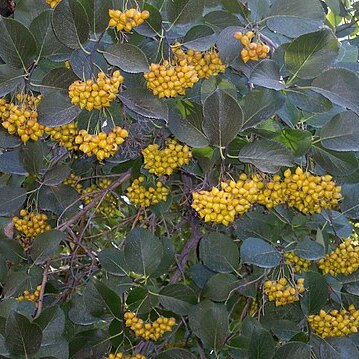Trees ca. 15 m tall; bark gray-brown, fissured; branches brown; branchlets light brown, pubescent. Petiole 1-4 cm, pubescent; leaf blade broadly elliptic, elliptic, ovate, or obovate, 8-25 × 4-15 cm, abaxially densely and minutely hispid, hairs discoid at base, extremely scabrous, adaxially densely pubescent, base cuneate or rotund, margin serrate, apex acute. Cymes terminal, corymbose or paniculate, 6-9 cm wide, bracteate or not; bracts linear, ca. 5 mm. Flowers sessile or nearly so. Calyx 3.5-4.5 mm, parted nearly to base; lobes oblong or ovate, pubescent. Corolla white to pale yellow, tubular-campanulate, fragrant, 8-10 mm, base ca. 2 mm wide; throat 6-7 mm wide; lobes oblong, 3-4 mm, shorter than tube. Stamens exserted from corolla; filaments 3-4.5 mm; anthers 1.5-2 mm. Style 6-9 mm, glabrous, rarely appressed pubescent, branches 1-1.5 mm. Drupes yellow, subglobose, 1-1.5 cm in diam.; endocarp divided at maturity into 2 2-seeded pyrenes. Fl. Mar-May, fr. Jun-Jul. 2n = 40*.
More
A tree up to about 15 m tall. The leaves are narrowly oval and have some hairs. The flowers are small and white to pale yellow. They are fragrant. They are in clusters at the ends of branches. The fruit are roundish and yellow. They are 12 mm across.
A tropical and subtropical plant. It grows on open forests on slopes, shaded moist hillsides between 100–2300 m altitude in China. It is best in light, humus-rich, well-drained soils. It needs an open sunny position. It is resistant to frost but damaged by drought. It suits hardiness zones 9-11. In Sichuan and Yunnan.
More
Open forests on slopes, shaded moist hillsides; at elevations from 100-2,300 metres. Warm rocky valleys in the warmer areas of C. and S. Japan. In evergreen forests near the sea.


